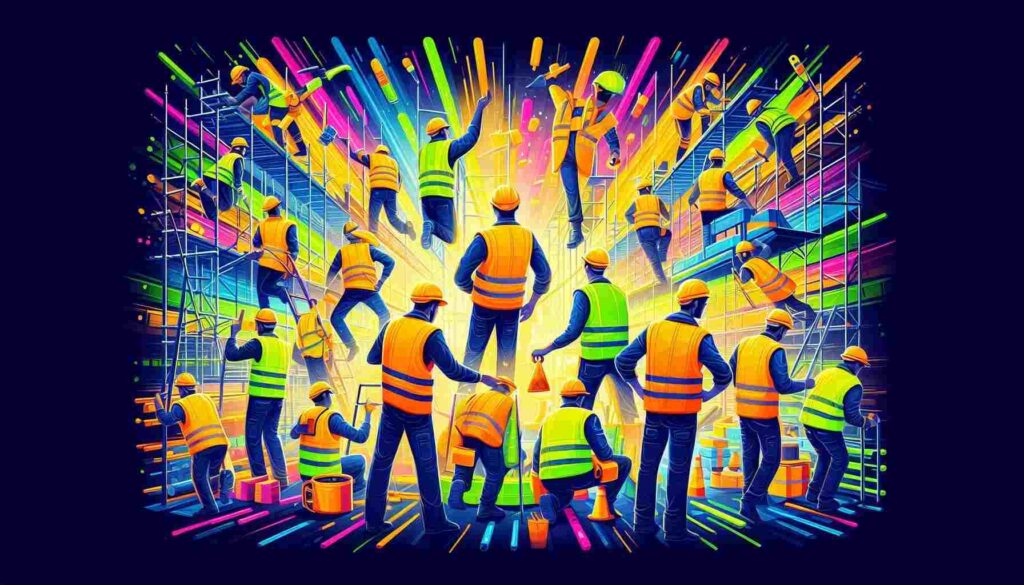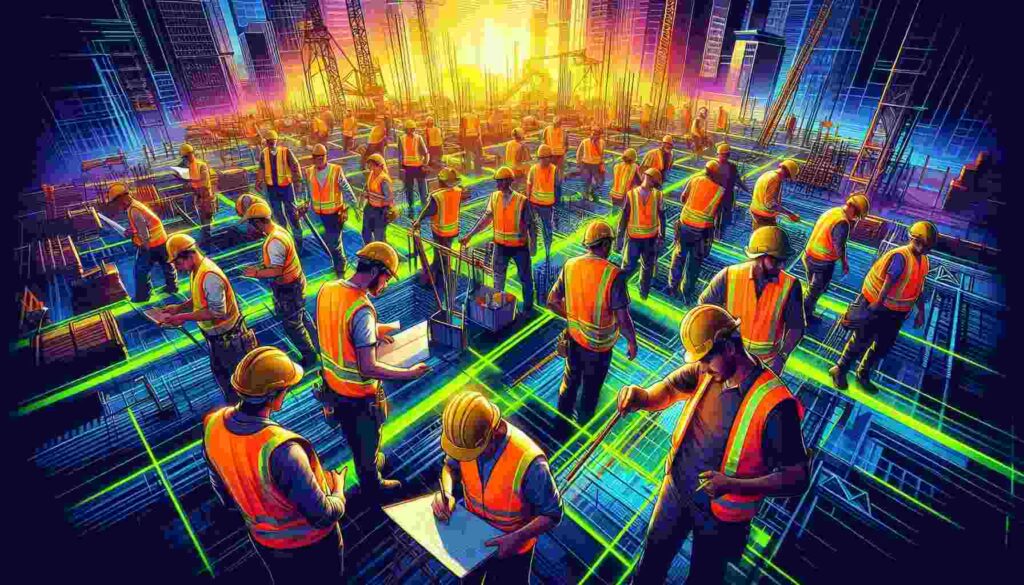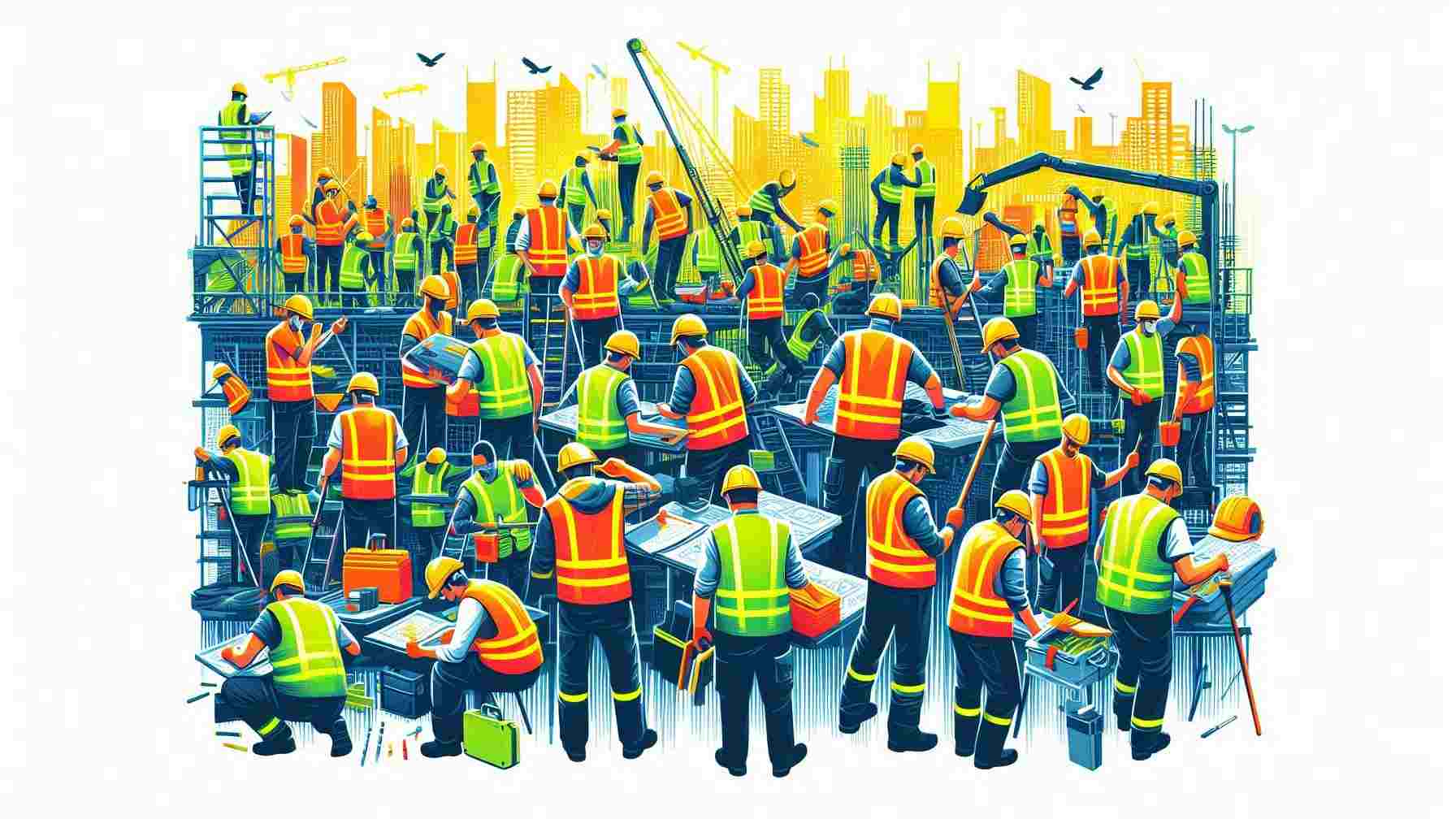You might be thinking, “It’s just a vest, what’s the big deal?” Well, let me tell you, these neon wonders are the thin line between safety and potential disaster in high-risk work environments. They’re not just mandatory in many workplaces; they’re a crucial tool in keeping workers visible and protected.
Key Takeaways:
- Construction vests are high-visibility safety gear designed to make workers easily noticeable in hazardous environments.
- They come in various classes and types, each suited for different work conditions and lighting situations.
- Proper care and maintenance of construction vests are essential for maintaining their effectiveness.
- Choosing the right vest involves considering factors like job requirements, climate, and personal comfort.

What Exactly is a Construction Vest?
At its core, a construction vest is a piece of personal protective equipment (PPE) designed to make the wearer highly visible in potentially dangerous work environments. These vests typically come in bright, fluorescent colors like yellow, orange, or lime green, often adorned with reflective strips that shine when hit by light.
But don’t be fooled by their simple appearance. These vests are carefully engineered to meet specific safety standards set by organizations like ANSI (American National Standards Institute) and OSHA (Occupational Safety and Health Administration). They’re not just about looking good – although, let’s be honest, who doesn’t love a good neon moment?
Construction vests come in different classes, each designed for specific work conditions:
- Class 1 Vests: These are the basic models, suitable for environments with low traffic speeds and ample separation between workers and vehicles.
- Class 2 Vests: A step up in visibility, these are ideal for moderate risk environments where traffic speeds are higher.
- Class 3 Vests: The highest visibility option, these are for high-risk situations with high traffic speeds or low light conditions.
I remember my first time donning a Class 3 vest for a night construction job. It felt like I was wearing a personal lighthouse! But boy, did it make me feel safer knowing I could be seen from a mile away.
Why Are Construction Vests So Important?
Let’s get real for a second. Construction sites can be dangerous places. You’ve got heavy machinery moving around, vehicles coming and going, and often, less-than-ideal lighting conditions. In this environment, being visible isn’t just nice – it’s necessary.
Construction vests play a crucial role in preventing accidents by making workers easily noticeable to vehicle operators, machine handlers, and other workers. They’re particularly vital in low-light conditions, like early mornings, evenings, or overcast days. The reflective strips on these vests can be seen from up to 1,000 feet away when illuminated by headlights!
But the benefits don’t stop at safety. Wearing construction vests can also:
- Improve overall site organization by making it easy to identify workers
- Boost worker confidence and morale by providing a sense of security
- Help comply with legal safety requirements and avoid potential fines
I once worked on a site where different colored vests were used to distinguish between various teams. It was like a neon rainbow of efficiency!

Choosing the Right Construction Vest
Now, you might think all construction vests are created equal, but that’s not quite true. Choosing the right vest for your needs is crucial for ensuring maximum safety and comfort. Here are some factors to consider:
1. Job Requirements
First and foremost, check what class of vest is required for your specific job. Different work environments have different visibility needs. For instance, if you’re working on a highway construction project, you’ll likely need a Class 3 vest due to the high-speed traffic.
2. Climate and Weather Conditions
Working in a hot, humid environment? Look for vests made with breathable materials to keep you cool. For colder climates, consider vests with insulation or ones that can be easily worn over warm clothing.
3. Fit and Comfort
A vest that’s too tight can restrict movement, while one that’s too loose might get caught in machinery. Try on different sizes and styles to find one that fits just right. Remember, you’ll likely be wearing this for long hours, so comfort is key!
4. Additional Features
Some vests come with extra pockets, tool loops, or even built-in hydration systems. Think about what would make your work easier and look for vests with those features.
I once made the mistake of choosing a vest purely based on price, without considering these factors. Let’s just say, spending a day in an ill-fitting vest in the scorching summer heat was not my idea of a good time!
Proper Care and Maintenance of Construction Vests
Alright, so you’ve got your perfect construction vest. Now, how do you keep it in tip-top shape? Proper care and maintenance are crucial for ensuring your vest remains effective over time.
Here are some tips to keep your vest in prime condition:
- Regular Cleaning: Wash your vest according to the manufacturer’s instructions. Generally, a gentle cycle with mild detergent works best.
- Avoid Harsh Chemicals: Stay away from bleach or fabric softeners, as these can damage the fluorescent and reflective materials.
- Air Dry: Skip the dryer and let your vest air dry. High heat can degrade the reflective properties.
- Inspect Regularly: Check for any tears, fading, or loss of reflectivity. If you notice any issues, it might be time for a replacement.
- Store Properly: When not in use, store your vest in a clean, dry place away from direct sunlight.
I learned the hard way that leaving a vest in the back of my truck for weeks on end wasn’t the best storage method. The sun faded it faster than my summer tan!
Remember, a well-maintained vest isn’t just about looking good (although that neon glow is pretty snazzy). It’s about ensuring you remain visible and safe on the job. Speaking of which, let’s dive into some of the latest innovations in construction vest technology…
Innovations in Construction Vest Technology
Hold onto your hard hats, folks, because the world of construction vests is evolving faster than you can say “safety first”! Gone are the days when a vest was just a piece of bright fabric with some reflective strips. Today’s vests are getting smarter, more comfortable, and dare I say, even cooler.
One of the most exciting innovations I’ve seen is the integration of LED lights into vests. These aren’t just any lights – they’re flexible, rechargeable, and can last an entire shift. Imagine being lit up like a Christmas tree, but for safety! I tried one of these on a night job last year, and let me tell you, I felt like a walking lighthouse.
Another game-changer is the development of climate-adaptive vests. These clever garments use phase-change materials that absorb, store, and release heat for optimal comfort. It’s like having your own personal thermostat! I remember wearing one of these during a sweltering summer project, and it felt like I had my own built-in AC.
But wait, there’s more! Some manufacturers are now incorporating wearable technology into their vests. We’re talking about vests with built-in sensors that can monitor vital signs, detect falls, and even alert supervisors if a worker enters a restricted area. It’s like having a tiny, high-vis bodyguard!
And for those of us who are always fumbling for our phones or tools, there are now vests with specially designed pockets and loops. No more playing hide-and-seek with your measuring tape! I once lost my phone on a site three times in one day before switching to one of these organizational wizards.
Lastly, let’s talk about sustainability. Many companies are now producing vests made from recycled materials. It’s a win-win – you stay safe, and Mother Earth gets a little love too. I feel pretty good knowing my vest might have been a water bottle in its past life!

The Future of Construction Vests
So, what’s next in the world of construction vests? If my crystal ball (and industry trends) are correct, we’re in for some pretty exciting developments. Imagine vests with built-in communication systems, allowing workers to stay in touch without fumbling for radios or phones. Or how about vests that can change color based on the time of day or weather conditions for optimal visibility?
There’s also talk of ‘smart’ vests that can interact with job site equipment, automatically alerting machinery operators when a worker is nearby. And for those of us who are always misplacing our PPE, there are whispers of vests with embedded tracking devices. No more ‘dog ate my vest’ excuses!
One thing’s for sure – the humble construction vest is anything but ‘just a vest’. It’s a critical piece of safety equipment that’s constantly evolving to keep workers safer, more comfortable, and more efficient. So next time you slip on that neon yellow vest, take a moment to appreciate the technology and innovation you’re wearing.
Remember, at the end of the day, the best construction vest is the one that keeps you safe and visible on the job. Whether it’s a basic Class 1 or a high-tech LED-equipped Class 3, wearing your vest properly and consistently is key. After all, you can’t put a price on safety – but you can put on a vest!
So, here’s to the construction vest – may it continue to shine bright and keep workers safe for many years to come. And who knows? Maybe one day we’ll have vests that can make us coffee too. A worker can dream, right?
Frequently Asked Questions
1. What is the purpose of a construction vest?
A construction vest is designed to make workers highly visible in potentially dangerous work environments. Its primary purpose is to prevent accidents by ensuring workers are easily noticeable to vehicle operators, machine handlers, and other workers, especially in low-light conditions or areas with moving vehicles or equipment.
2. How often should I replace my construction vest?
The lifespan of a construction vest depends on its usage and care, but generally, you should replace your vest when it shows signs of wear and tear, fading, or loss of reflective properties. This could be anywhere from 6 months to 2 years. Always inspect your vest regularly and replace it if it’s no longer meeting safety standards.
3. Can I wash my construction vest?
Yes, you can and should wash your construction vest regularly. However, always follow the manufacturer’s care instructions. Typically, vests can be machine washed on a gentle cycle with mild detergent. Avoid using bleach or fabric softeners as these can damage the fluorescent and reflective materials. Air drying is usually recommended over machine drying.
4. What’s the difference between Class 1, Class 2, and Class 3 vests?
The classes refer to different levels of visibility and protection:
– Class 1 vests are for low-risk environments with slow-moving traffic.
– Class 2 vests are for moderate-risk environments with faster-moving traffic.
– Class 3 vests offer the highest visibility and are for high-risk environments with high-speed traffic or low-light conditions.
The higher the class, the more reflective material and background fabric the vest will have.
5. Are there specific color requirements for construction vests?
Yes, construction vests typically come in fluorescent yellow-green, orange-red, or red. The exact color requirements can vary depending on local regulations and specific job site rules. However, these bright, highly visible colors are chosen because they contrast sharply with most backgrounds and are easily noticeable.
6. Can I wear my own clothes over my construction vest?
No, your construction vest should always be the outermost layer of clothing. Wearing anything over your vest defeats its purpose of making you highly visible. If you’re cold, look for insulated vests or wear warm layers underneath your vest.
7. Are there vests designed for specific weather conditions?
Yes, there are vests designed for various weather conditions. For hot weather, there are vests made with lightweight, breathable materials. For cold weather, you can find insulated vests or those designed to be worn over heavy clothing. Some advanced vests even use climate-adaptive materials to help regulate body temperature.
8. Do construction vests expire?
While construction vests don’t have a specific expiration date, their effectiveness can decrease over time due to wear and tear, exposure to sunlight, and frequent washing. The reflective properties can degrade, and the fluorescent color can fade. It’s important to regularly inspect your vest and replace it when it no longer meets safety standards.
9. Can I customize my construction vest?
In many cases, yes. Many manufacturers offer customization options such as adding company logos or worker names. However, it’s crucial that any customization doesn’t interfere with the vest’s reflective properties or visibility. Always check with your safety manager before making any modifications to your PPE.
10. Are there alternatives to traditional construction vests?
Yes, there are alternatives to traditional vests, although their use depends on specific job requirements and regulations. Some alternatives include:
– High-visibility t-shirts or long-sleeve shirts
– High-visibility jackets or coats
– Full high-visibility coveralls
– High-visibility harnesses (for jobs requiring fall protection)
Always check with your safety manager to ensure any alternative meets the required safety standards for your specific job site.






